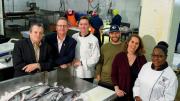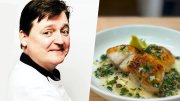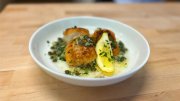It started with apples. In the 1990s and early 2000s, Harvard University Dining Services (HUDS) focused on small changes to the food-buying process as it sought to become more sustainable. What kinds of foods could it buy locally? Apples worked. “It was sort of, maybe pun-intended, the low-hanging fruit,” said HUDS director of strategic initiatives Crista Martin.
But there came a point when it had done all the easy stuff. HUDS was buying from plenty of local companies, but in a traditional manner: when a product was available, Harvard bought it; when none existed, HUDS sought it elsewhere. “But when we wanted to expand that and change the paradigm a little bit, it required a lot more work,” Martin said. Today, HUDS follows principles from the Menus of Change Initiative, developed by the Culinary Institute of America and the Harvard Chan School of Public Health, and the Sustainable and Healthful Food Standards released by Harvard’s Office for Sustainability in April. Both encourage more plant-based products and less inhumanely produced meat.
HUDS still purchases from local vendors, but now, it wields more influence—requesting changes from vendor companies to make products sustainable. “We’re about to talk to our chicken supplier and say, ‘Listen, when are you going to start making these changes to your product?’” said HUDS managing director David Davidson, over lunch in Dunster House’s dining hall (see Harvard Portrait, May-June 2018, page 17). HUDS does not purchase meat of chickens that have ingested antibiotics, and its eggs are certified cage-free, but it can still push its vendors toward more humane practices, like leaving bales of straw for chickens to peck—a diversion from the cramped, stimulus-free environment chickens endure in many factory farms.
In fiscal year 2018, HUDS served 2,731,078 meals to undergraduates. In a week, it buys about 1,600 pounds of fish. During the academic year, students consume 15 to 20 tons of squash. Dining services are not subsidized by Harvard; funds come from the meal plans of Harvard’s undergraduates, which are required for all students living on campus. With a set amount of revenue each year, and a population of opinionated student-customers from around the world, HUDS pursues steps that will improve taste and quality and, increasingly, lessen the environmental impact of its food.
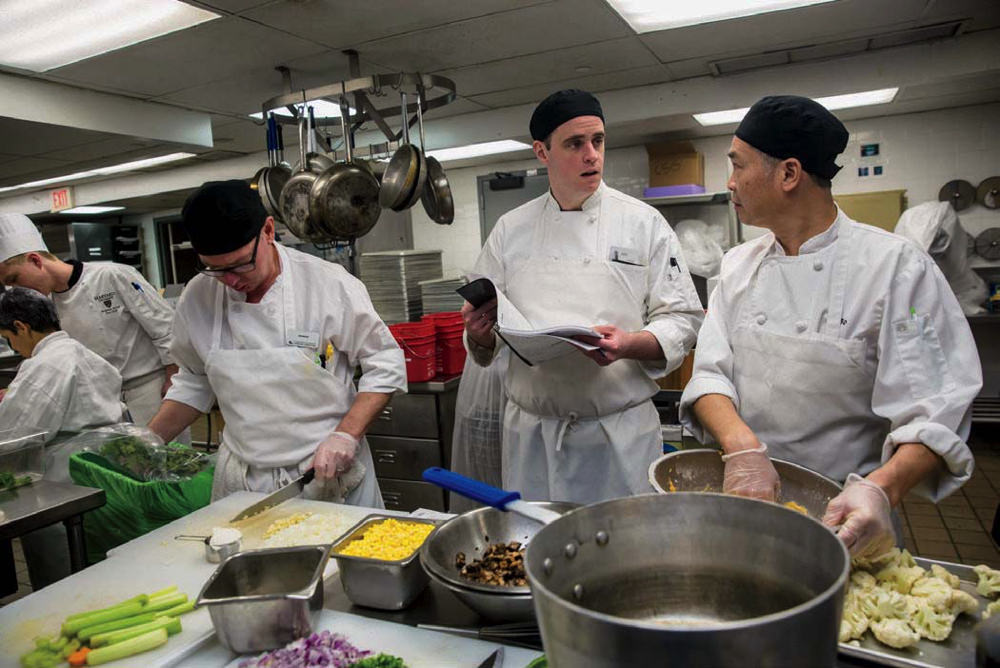
Harvard dining-hall employees take a vegan culinary training class.
Photograph courtesy of Harvard University Dining Services
In doing so, HUDS hopes to expand a Harvard education into the dining halls, doing its best to engage students in the nuances of the food they eat, and reflect student values in its menu. When no good options exist, HUDS works with its partners—at Red’s Best, Commonwealth Kitchen, Costa Produce, and others—on long-term solutions. And when Harvard finds a solution, other universities follow.
Harvard, as noted, buys lots of fish. In the winter, when local produce becomes scarcer, it is a good way to continue to “buy local” and show students what it means to eat in New England, Martin said. But fish, and fish stocks are unpredictable—and when feeding thousands of consumers at every meal, unpredictability, both in price and quantity, poses challenges.
Jared Auerbach, founder and CEO of Red’s Best, a wholesaler for small, independent fishermen, struggled too with what he called “a misalignment of supply and demand.” For years before he started selling to Harvard, he discussed with HUDS what a modern local fishery looked like. What are the challenges, and how could large-scale, influential buyers like Harvard direct their purchases to have a positive effect on the system? “We have this beautiful, amazing fishery right now where we’re interacting with Mother Nature in this beautiful appropriate way,” Auerbach said. “But that leads to what you’d expect from Mother Nature, which is unpredictable and everchanging and unknown.” Buyers, accustomed to just a few types of fish, may want haddock on a day when a fisherman catches hake. The disparity can lead to purchasers looking thousands of miles away for overharvested fish, which are environmentally unfriendly to catch and to ship.
The solution: variable fish, but at a fixed volume and price point. What Harvard gets depends on the weekly catch—hake, haddock, skate, dogfish, or monkfish. “And when we buy those underutilized species, it means the fisherman gets a living wage for his fishing trip,” Davidson said. “It means he can earn a living because he can sell everything that he touches—not just the cod.” To adjust to a variable product, HUDS director for culinary operations Martin Breslin and residential dining executive chef Akeisha Hayde prepared recipes that can work for several similar fish. The dining halls often display photos and bios of those who caught the catch of the day. Once the program worked at Harvard, other schools started picking it up. It’s been adapted by Cornell, Yale, Northeastern, and even K-12 public schools.
Harvard has made similar changes in its sourcing of produce, working with Costa Fruit and Produce, a HUDS collaborator for 25 years. All the farms Costa deals with are in New England. In the winter, when many crops aren’t available, Harvard buys anywhere between 30,000 and 40,000 pounds of winter squash—a thick-skinned squash that stores through the cold months—from Ward’s Berry Farm in Sharon, Massachusetts. “We’ll take whatever they harvest off that acreage there,” Davidson said. If a farmer produces an extra 50 cases of swiss chard, Jim Elise, who works on Harvard’s account with Costa Produce, will let HUDS know and they will usually take it in, he said. Breslin and Hayde can adjust the menu quickly, giving local farmers latitude to produce more than they planned. Costa responds as well, washing, soaking, and cutting the extra produce to HUDS’ specifications for a specific dish. During peak periods of growth, 70 percent of Harvard’s produce is grown locally.
It’s not just a matter of buying what’s available, though. Massachusetts ranks forty-seventh in agricultural production in the United States. Instead of accepting low production as a given, HUDS helps farmers produce more crops. Recently Harvard, along with Tufts University and Boston College, received a $250,000 grant from the New England Food Vision Prize through the Henry P. Kendall Foundation to incentivize small-scale area farmers to expand their acreage of farmland in production. Sometimes farmers aren’t using all of their available land, or not using it effectively, because they need something, Martin said. If HUDS can get these farmers to build a greenhouse, get better equipment, or improve their irrigation systems, it means more local produce for Harvard and the whole region.
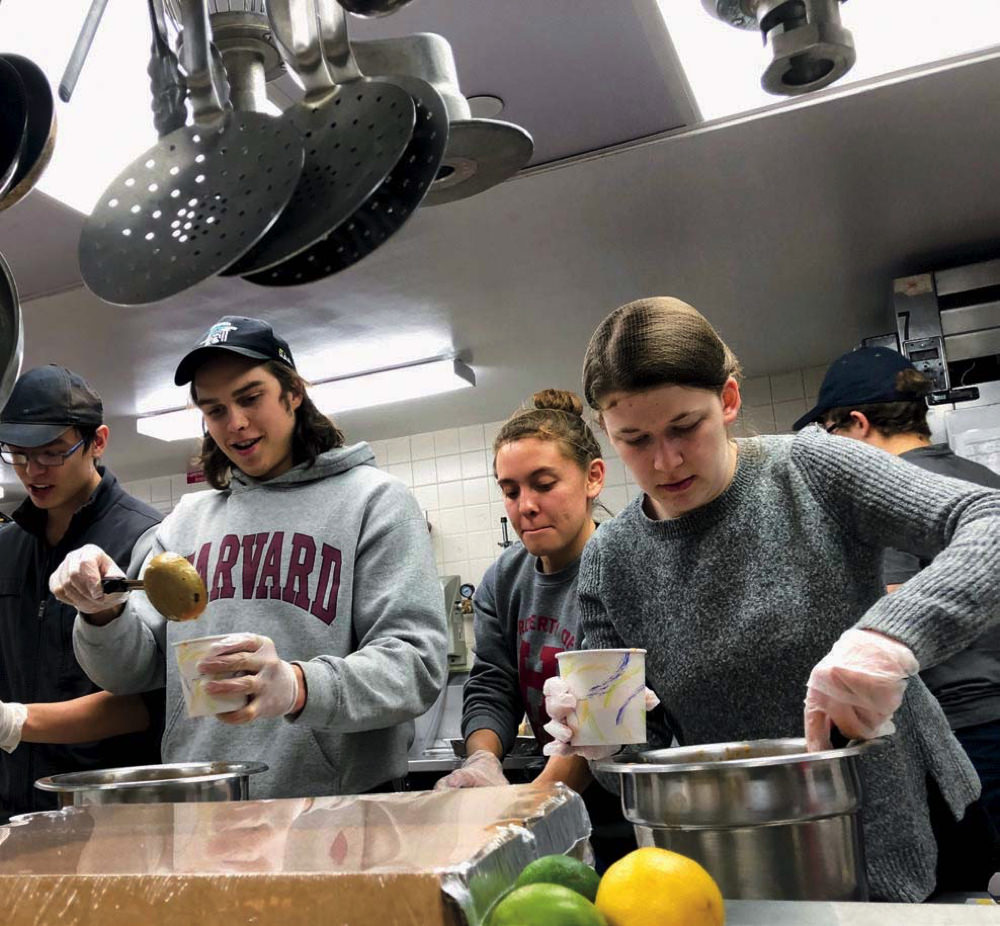
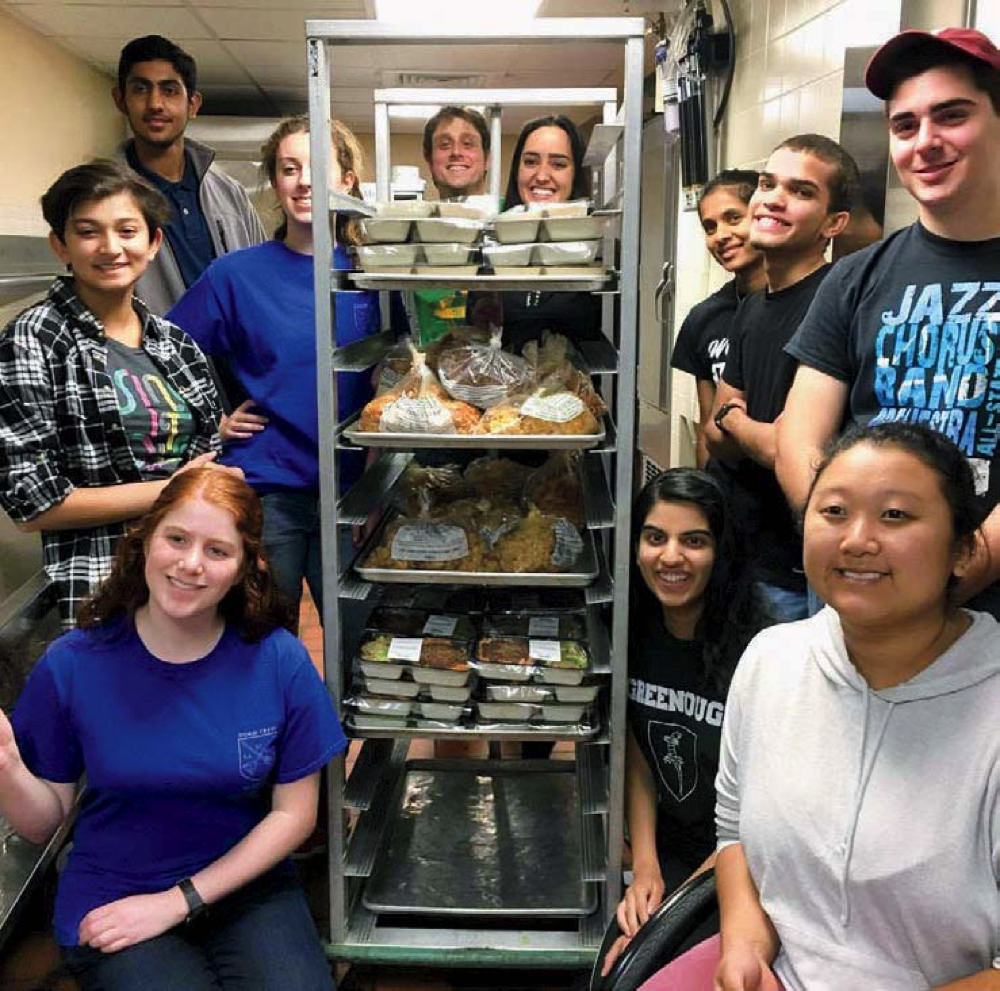
Student volunteers package excess food for Family Meals, a program through Food For Free that offers individual meals to those in need.
Photograph courtesy of Harvard University Dining Services
The local outreach isn’t limited to fish and produce. Many of the products it serves—from specialty sauces to hummus and apple crisps—come from Commonwealth Kitchen, a nonprofit food business incubator in Dorchester, Massachusetts. Commonwealth Kitchen executive director Jen Faigel said that she talks with HUDS about what dining-hall items it would like to add or adjust, and then seeks a solution through one of its business owners. When a local farmer had too much arugula and kale in a saturated market, for example, Commonwealth turned the greens into a pesto, and sold it to the University. Faigel said it often looks to Harvard when one of its business owners—often low-income women and immigrants—is seeking a buyer for specialty sauces: Indian simmer sauce, African peanut sauce, or Haitian pikliz. With a sizable cosmopolitan population to feed, HUDS appreciates getting access to international flavors produced just a few miles away—while supporting local enterprises and reducing the financial and energy costs of shipping.
Martin and Davidson aren’t trying to do away with people’s favorites. Davidson said the process is more about having a balance. If a short-rib special is on offer one night, the menu will also include an enticing vegetarian alternative, like portabella mushrooms. Martin said some of the most positive feedback HUDS gets from students involves well-seasoned vegetable dishes, like chili-roasted green beans, buffalo cauliflower, and edamame pot stickers. If people want to pursue a vegan diet, HUDS’s goal is to make it easy. If someone wants a double burger off the grill, that should be an option, too. Martin hopes that, in time, some of the double-burger fans will perhaps make it a double Beyond Burger—a plant-based patty that resembles the real thing.
Consumers’ decision-making ultimately depends on what they know, and education is central to HUDS’s mission. Students who don’t know what a Beyond Burger is will be less inclined to try one. If they are made aware of where the dining halls’ squash comes from, they have learned something about local sourcing and the energy use inherent in the food supply. A lot of that education is done through the Food Literacy Project, HUDS’s food-education initiative, which employs a student from each House as a fellow. The fellows, along with the program’s manager, host more than 100 events a year on campus, from guest lectures and discussions with chefs to cooking classes and farm tours.
Part of teaching students is exposing them to what the options are; another is giving them a voice in the process. HUDS first introduced Beyond Burgers in Annenberg, where students were asked to try them out and decide whether they wanted to see them more often. Most said yes, and the burgers are here to stay. When Davidson hears requests for items not on the menu, he sometimes pitches the proposal to other students, because a static budget means that any addition comes at the cost of something else. Would students sacrifice cookies and brownies for a fresh fruit bar another night of the week? The answer so far, he said, is no.
Students have also played a vital part in Food for Free, a food-recovery program that donates food to community groups throughout the Greater Boston community. Four days a week after dinner, students pack any unused food into individual meal containers; it is then shipped across the Boston area. In 2015, the program’s first year at Harvard, HUDS donated approximately 55,000 pounds of food. The 2017 and 2018 totals were slightly above 25,000 pounds each—a decrease Martin attributes to better-planned and more efficient meal production. When the program worked at Harvard, HUDS employees let other institutions know how to integrate it into their own dining programs, said Food for Free executive director Sasha Purpura. “They’ve brought people in and met with them to talk through how it works and why it’s safe, how it is not a significant hit on staff time…and their willingness to share has successfully encouraged others to begin the food-donation program.”
In their HUDS roles, Martin and Davidson try to be more proactive than reactive. Davidson recalled the challenge the dining halls went through in the fall of 2011 when student activists campaigned for cage-free eggs. HUDS ultimately obliged, costing the program an additional $100,000, according to former assistant vice president for campus services Ted Mayer. Today, HUDS uses the Menus of Change Initiative as a roadmap for improvements, trying to make adjustments with its vendors continuously, pushing for a plant-forward menu with more humanely treated animal products before there is external pressure to do so.
“It sounds really simplistic and silly, but I’m really into the stuff that works,” said David Havelick, sustainability manager at the Office for Sustainability, which works with HUDS on its long-term food vision. The University can go all-in on veggie burgers, he points out, but if no one eats them, there’s simply more wasted food. He recalled a time when the University tried going meatless one Monday—only to see meat consumption triple the next day.
HUDS doesn’t foresee any time limit to improving its environmental footprint. It has seen how its initiatives have worked out at Harvard and other schools, and it hopes to keep building on its work. “I think we’re beginning to recognize that food is sort of a universal medium for conversation, for discussion, for learning,” Martin said. “No matter what your area of expertise or interest, you have the capacity to engage the system and make it better.”
